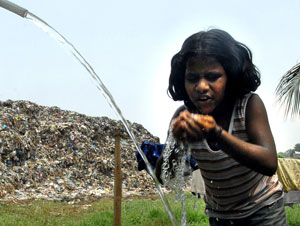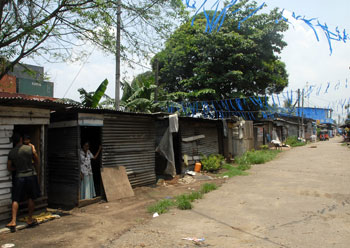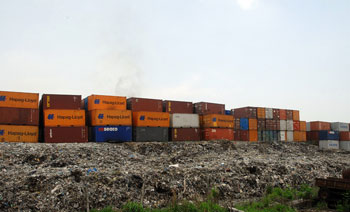Colombo city and suburbs are facing a serious environmental crisis and residents face a huge health risk as tons of waste and garbage continue to accumulate to mountainous proportions. Meanwhile, officials are blaming one another for the garbage crisis.
“Welcome to the City of Colombo” says a signboard at the entrance to the city. The irony is that the brightly painted sign stands next to a mountain of garbage. According to people living in the area, the garbage dump has been an eyesore and a health hazard for years.
 |
| Children and babies are at greatest risk from the garbage and waste being deposited daily in Sedawatte. |
Responsible parties at the centre of the crisis are the Colombo Municipal Council (CMC), the Urban Development Authority (UDA), the Ministry of Environment and private contractors. For various reasons, these parties have been unable to work together to find a permanent solution to the garbage problem that has been plaguing the city for the past 16 years or more.
Those most affected by the accumulation of the city’s garbage are the hundreds of shanty dwellers living in Bloemendhal and Sedawatte, areas marked as dumping sites for the city’s waste and garbage.
The garbage dumped at Bloemendhal is sorted out for recycling purposes, while the garbage dumped at Sedawatte is not for recycling.
L. Asanka, a resident of Kelani Tissa Gama, at Weragodella, Sedawatte, said that he and 241 other families have lived right next to the rotting dump for years. He said the garbage has almost reached his front door.
Despite complaints from the shanty-dwellers, the authorities continue to do nothing, he said.
Mr. Asanka said much of the waste comes from hospitals and is contaminated.
 |
 |
| L. Asanka |
W. A. S. Perera |
“The situation is especially bad when it rains,” he said. “The stench is unbearable, mosquitoes start breeding and life becomes intolerable. The children and the babies are the worst hit.”
The garbage is dumped in an area in Sedawatte that was formerly marshland, rich in grass and foliage, and once served as a source of fodder for animals at the Dehiwala Zoo.
“This has changed. There are some 15 to 20 acres of land now covered with old and recent garbage. This land can never be used again for any other purpose,” Mr. Asanka said.
Another irate Kelanitissa Gama resident, L. W. L. Sanjeewa, said: “It takes only a light shower for the whole place to become inundated. Flooding happens quickly because there is no marshland for the water to soak into. When it rains, we are forced to move to higher ground.”
Another problem is that shipping containers are dumped on top of the piles of flattened garbage.
Resident W. A. S. Perera said the vibrations caused by dropping large containers on the dumps were affecting the foundations of their homes. This activity goes on all day and even at night, he added.
He said the residents were powerless to do anything, because the parties involved invariably bribed anyone who tried to take action or intimidated those who raised complaints.
“The future is bleak for us. Sooner or later the garbage will reach roof level,” said Lal Dammika, another resident.
Meanwhile, Saliya Perera, general manager of Burns Trading Company, a private company hired by the CMC to dispose of city garbage, told The Sunday Times that the bulk of the waste was recycled as fertiliser. He admitted that hospital waste was also being dumped in the Sedawatte area.
“To minimise the health risks, Burns Trading has undertaken to cover the garbage with a layer of tar, so that empty containers can be loaded on top of the garbage. This is better than leaving the garbage exposed,” he said.
He said there were other issues as well, but would not elaborate as there was a court case pending involving the CMC and Burns Trading.
Mr. Perera said Burns Trading was concerned about the effects of the rubbish dump on the neighbourhood.
 |
| Shanty-dwellers talk of the nightmare of living in the shadow of a growing mountain of garbage. |
 |
| The bang and crash of shipping containers being dumped on top of the garbage is causing damage to the homes of residents. |
“Whenever there is a problem, it is we who come forward to help the residents. No one else comes forward to help, but everyone is quick to criticise us,” he said. “We have built new homes for those who lost their houses as a result of our operations. No one mentions this. Where are all the NGOs and those others who are so quick to voice their concerns for the public good and who make a noise over much smaller issues?
“It is unfair to blame us all the time when there is bureaucratic bungling with other issues,” he said.
Western Provincial Council UNP leader Kithsiri Kahatapitiya said the government had to take full responsibility for the city’s garbage disgrace.
He said the Provincial Councils lacked the funds and were powerless in dealing with such matters.
“There is no proper policy in dealing with the garbage issue, The government is allowing the garbage crises to swell into a full-blown health crisis.
“I doubt there is any other city in the whole of South Asia where such a situation has been allowed to grow to such proportions. Besides the bad impact on the environment, it is bad for the country’s image,” Mr. Kahatapitiya said.
Environment Minister Champika Ranawaka said Burns Trading claims the Colombo Municipal Council owed it Rs. 400 million for its garbage disposal services, while the CMC accuses Burns Trading of not acting in accordance with the agreement. The Urban Development Authority, the Colombo Municipal Council and the private company are working on a joint action plan which will be ready by next week, the minister said.
Minister Ranawaka said a lack of proper zoning in urbanised areas was one of the reasons for the garbage disposal problem.
UDA threatens to take over
Minister of Urban Development, Dinesh Gunawardene, said the Urban Development Authority (UDA) would acquire sites allocated for garbage disposal if the Colombo Municipal Council and others involved in the city’s garbage disposal work failed to deliver.
Should that happen, Mr. Gunawardene said, the Ministry of Environment would implement its own solid waste management programme.
The minister cited similar situations in Kandy and Kalutara. “We took over solid waste management operations in Kandy and Kalutara when the municipal councils of both districts failed to implement proper disposal systems,” he said.
Minister Gunawardene said it was decided at a Tuesday meeting at the Parliament complex that all parties involved be given seven days to submit a report on matters pertaining to garbage disposal.
Meanwhile, the UDA is looking for alternate sites to dump garbage generated in the districts of Colombo, Gampaha, Kalutara and Kandy.
Rubbish disposal stalled
Garbage collecting in the city has come to a temporary halt because of a lack of space for the final disposal of garbage, according to CMC solid waste management director, P. Thangamayil.
“We cannot go collecting garbage in the streets as garbage trucks are full and there is no way to dispose of the garbage,” he said.
Mr. Thangamayil said there was also a legal problem that was holding up waste disposal.
According to Mr. Thangamayil, the private company, Burns Trading Company, has agreed to dispose of accumulated garbage and not allow it to pile up, while the CMC has agreed to pay the company 40 percent more for its services.
The Sunday Times understands that neither party has acted according to the agreement.
Breeding ground for diseases
Health officials fear that the present system of garbage disposal could result in serious pollution problems and the outbreak of disease.
“If garbage dumps are not covered with layers of soil, it could lead to the spread of infection, even to areas far from the dump,” according to CMC chief medical officer Dr. Pradeep Kariyawasam. “The pollution would continue for more than 15 years.”
Dr. Kariyawasam said containers and plastic bags were common breeding spots for mosquitoes, and that all the recent dengue-related deaths were reported from Modera and Mattakkuliya, which were close to garbage dumps.
Leptospirosis (rat fever), hepatitis and water-borne diseases are some of the diseases found in neighbourhoods where there are garbage dumps, while elderly persons and children suffer from asthmatic conditions.
“The air in these areas is highly polluted, and flammable methane gas forming over the dumps could result in an explosion,” he said. |





